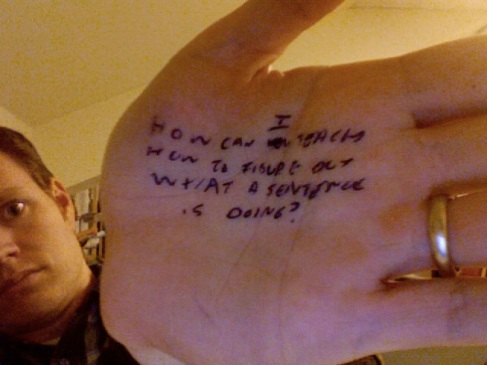How Do I Teach My Students How to Figure Out What a Sentence Is Doing?
The little moments I hate about teaching happen when I am trying to get my students to understand what I think is a fundamental principle of writing, and then, in my efforts to illustrate it, or have them learn it themselves, I realize that I have not only missed the mark, but I have no idea what I am talking about. Case in point: today I was teaching them about connecting sentences and making transitions. I had them play the game in groups where one person writes a sentence and then passes the paper, the next person writes the next sentence and then folds the paper down so that only their sentence is visible, and then passes it to the next person and so on. My thinking was that they would be able to focus on reading the sentence, coming up with what they wanted to say, and then using the best kind of transition to phrase the next sentence that would not only add more information but show how the information is connected. We did the activity; it was fun. One group wrote a story about a bear who gave himself the Heimlich maneuver with a rock and then he stubbed his toe on the rock and a fox stole his honey. Pretty funny. But at the end, I started to ask them questions like, “How can we apply this to our writing?” All I got back was vague answers like “Flow,” and “Make transitions.” So then I started to push them to elaborate. Still more empty answers, and not even much to build on. So I took over and explained what I was thinking. In order to make transitions, you have to first determine what the two sentences are doing and how they build on each other in order to choose the most appropriate way to transition. For example, These two sentences. “I am writing this blog to figure something out. I figure stuff out better by writing.” I would have to see that the first sentence is justifying an action, and the second is another justification. So the best way to “transition” between these sentences I would be better off combining the sentence or using “because,” “I am writing this blog to figure something out because I figure stuff out better by writing.” But then I can see that it’s not additional information, it’s a cause and effect relationship, but I couldn’t see that until I tried a transition. Then I realized that I have no idea how to “figure out what a sentence is doing.” The worst part is, most of the time I kept telling them, this is something that feels natural and we do it without thinking. So there I was up there telling them to think through something that they do naturally without thinking. But I didn’t know that yet. I knew the lesson had gone poorly, and that they got very little out of it (I didn’t get anything out of it either. In fact, I left more confused as you can see.) I wrote on my hand the title of this entry.
I was miffed that the lesson had gone poorly. I hated that I didn’t know how to teach what I wanted them to do. I am starting to be very aware that it was a stupid conceit for a lesson anyway. Teaching transitions by themselves is like asking a guitar player to practice moving from an F chord to an A chord. It just doesn’t make sense outside of the context of when you actually do it.
Long story short, I gave them crappy advice. I taught crappily.
It doesn’t help that I spent much of yesterday reading Hillocks Teaching Writing As a Reflective Practice and reading about awesome teachers like the McCabe guy he describes in Chapter one that just has the students teach themselves. I still have a long way to go.
The answer to the question in the title is, you don’t. Either they teach themselves, or it isn’t necessary.